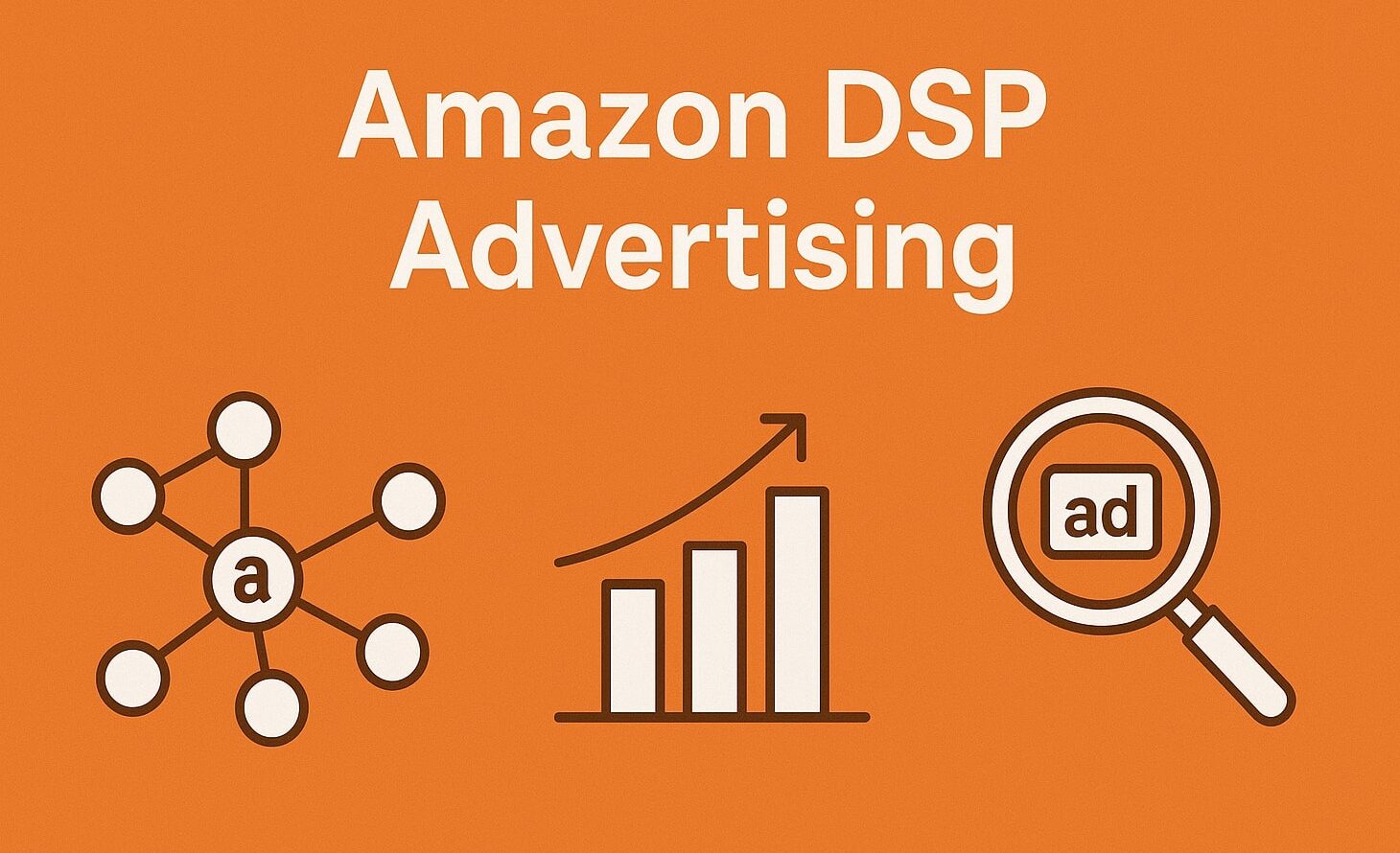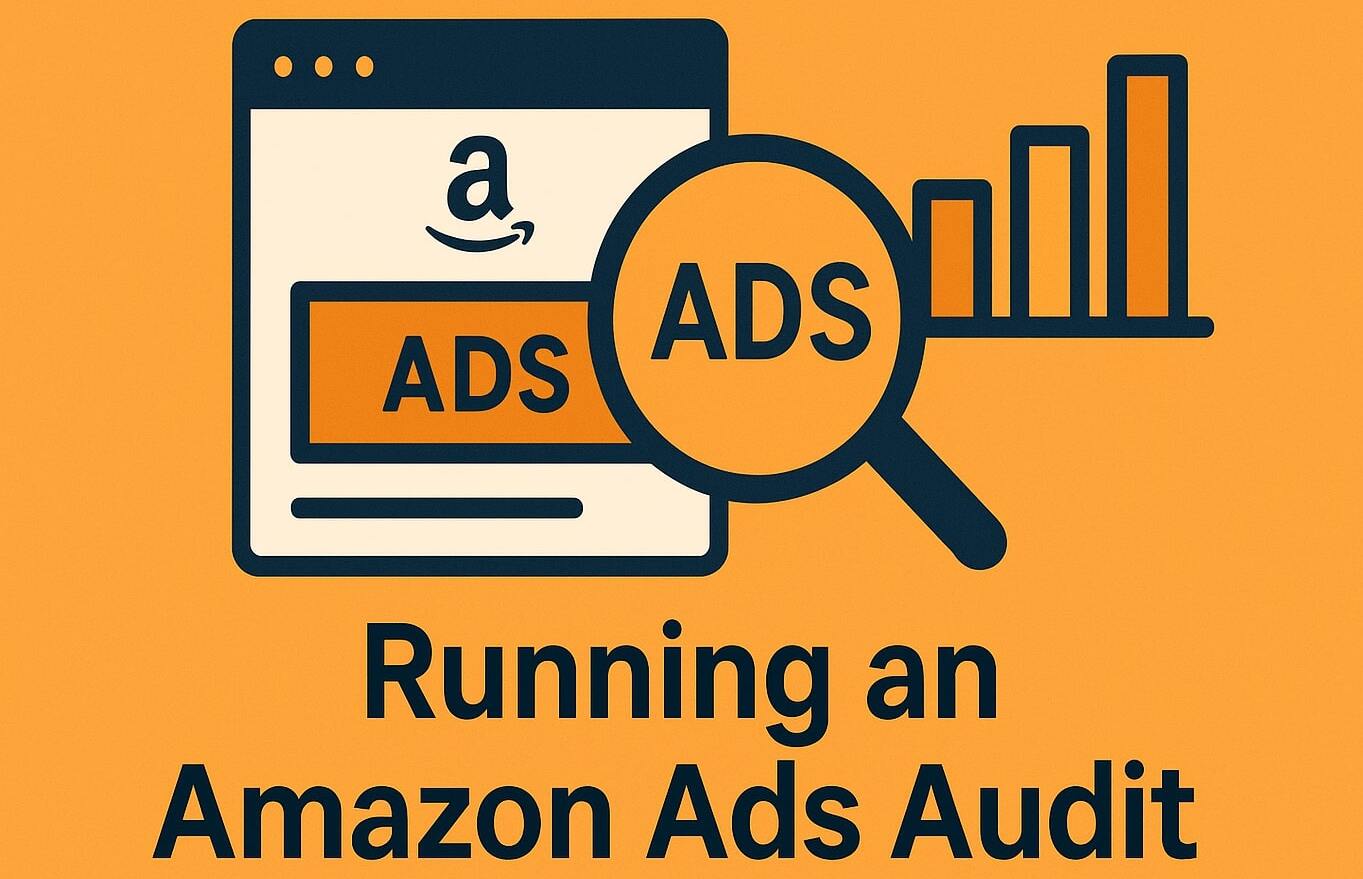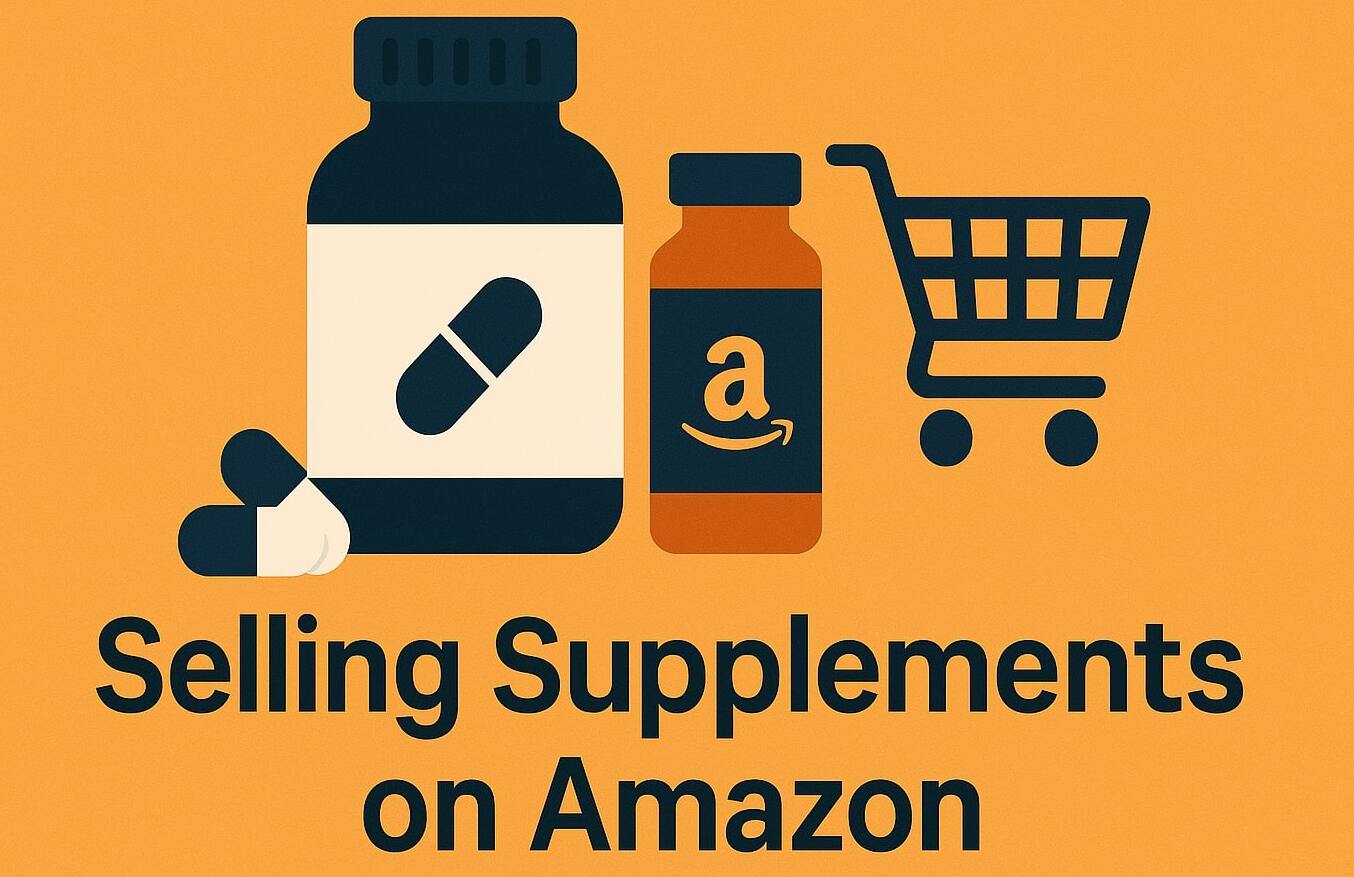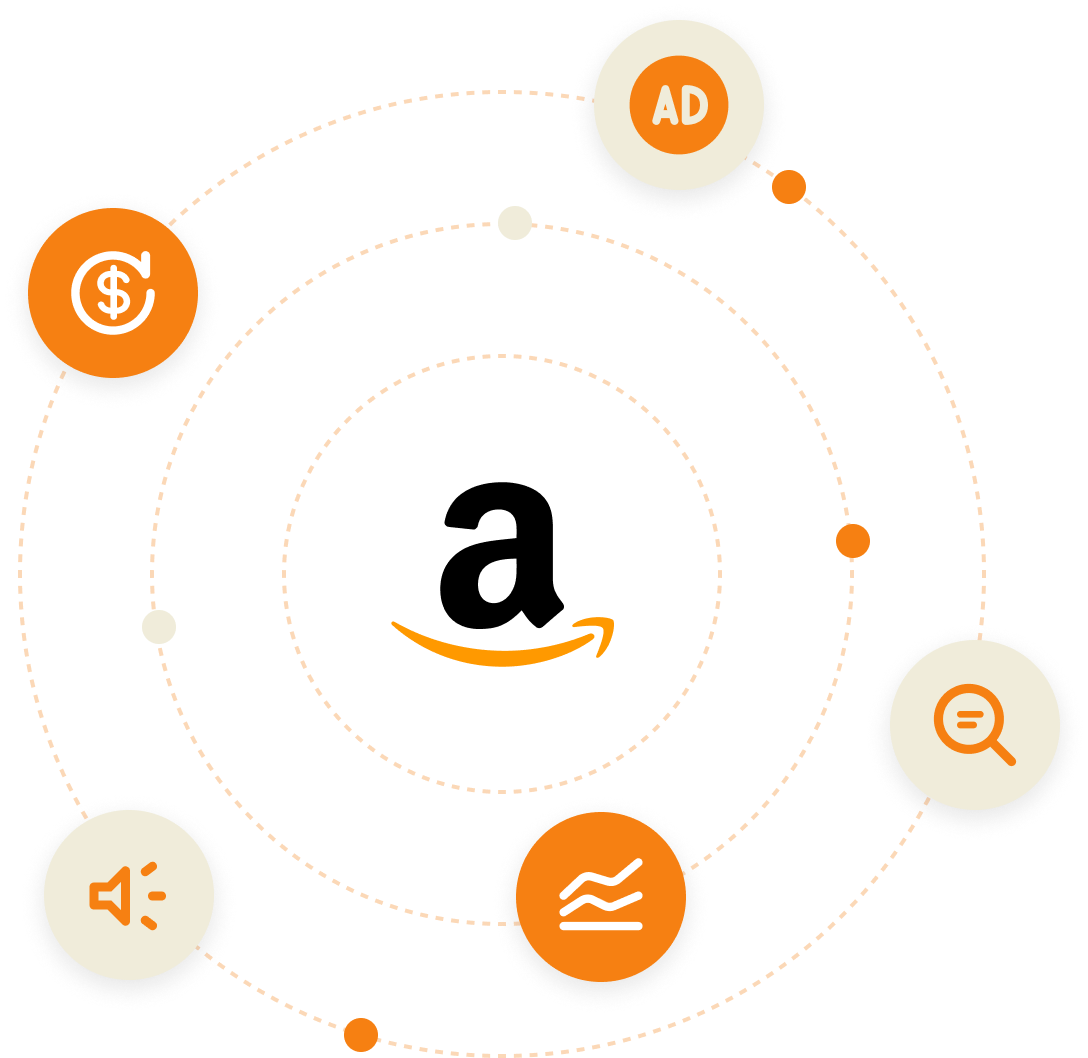With over 2 million active sellers on Amazon, simply listing a product and waiting for the magic to happen isn’t enough.
Amazon’s advertising platform is a game changer that boosts visibility and targets high-intent buyers.
But what happens when your ad performance hits a ceiling?
Enter Amazon Demand Side Platform (DSP) – an advanced advertising solution for sellers looking to take their brand to the next level.
Let’s dive into what Amazon DSP is, how it works and if it could be the key to unlocking your ultimate growth strategy.
Is Your Amazon Store Reaching Its Full Potential?
Discover hidden opportunities, reduce wasted spend, and boost your sales with a free expert audit.
Our team will analyze your listings, ad performance, and overall account health to uncover exactly what’s working—and what’s holding you back. You’ll get a tailored blueprint to scale smarter, not harder.
Get a Free AuditWhat is the Amazon Demand Side Platform (DSP)?
Amazon DSP (Demand Side Platform) is an advertising platform that allows advertisers to buy display, video, and audio ads programmatically, reaching customers both on Amazon sites and across the web.
https://www.youtube.com/watch?v=Zo1nXhuUdak
Unlike search-based advertising, DSP uses Amazon’s first-party data, such as shopping habits and browsing behavior, to target ads at the right audience, even off-platform. This means you can re-engage past visitors or introduce your product to new, highly relevant audiences both on and off Amazon.
Amazon DSP is a game-changing tool for brands looking to scale their advertising efforts and drive measurable results.
How exactly does Amazon DSP work?
Programmatic Advertising
Unlike traditional methods of purchasing ads directly from publishers, Amazon DSP operates through programmatic advertising – an automated method of buying and selling digital ad space in real time.
Essentially, Amazon DSP acts as a middleman between the supply side (publishers selling ad placements) and the demand side (advertisers seeking visibility). Amazon purchases ad space from the supply side and sells it to the demand side.
Key Features of Amazon DSP
1. Audience Targeting: Access Amazon’s first-party data, including shopper behavior, purchase history, and demographic insights, to define and target relevant audiences.
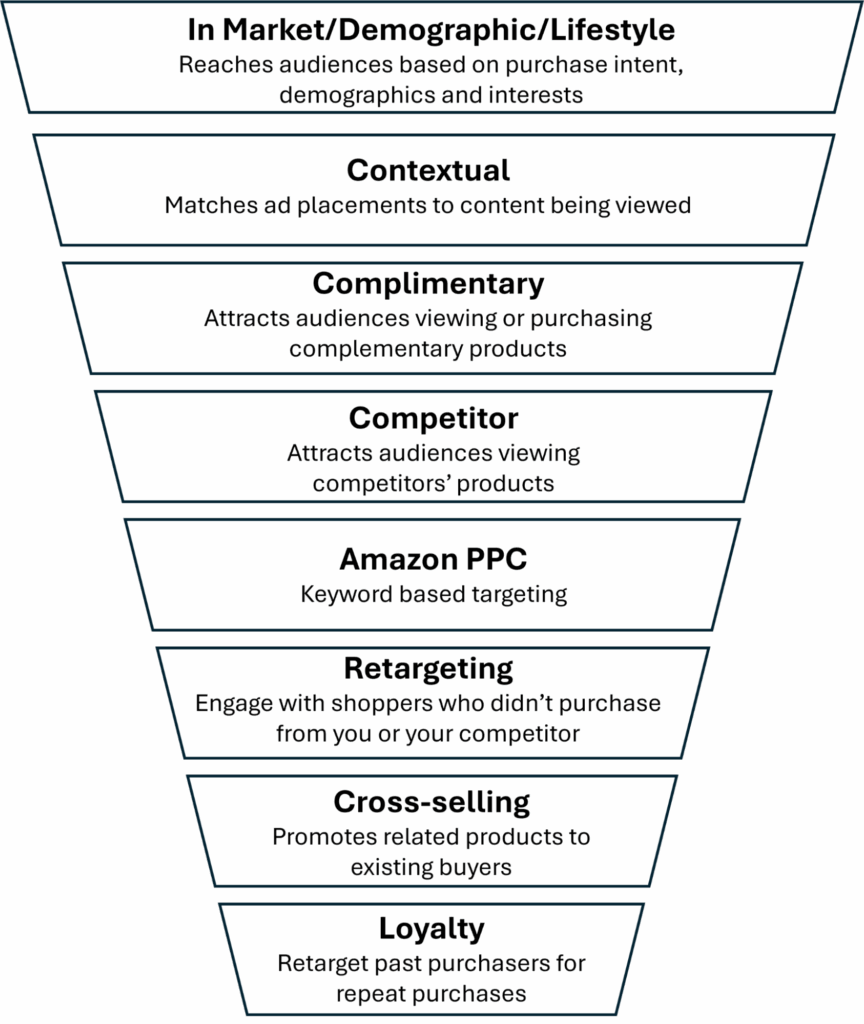
DSP Funnel Segments
2. Placement Options: Choose where ads will appear
- Amazon.com
- Amazon Mobile app
- Amazon Mobile Web
- IMDb TV
- Freedive (IMDb Streaming)
- Twitch
- Fire TV and Fire tablet
- Kindle Devices
- Amazon Publisher Services (APS)
- Amazon Publisher Direct
- 3rd Party Exchanges
- Digital Signage apps
- Mobile apps
3. Creative Flexibility: Use responsive e-commerce ads, video, audio or custom ads to engage audiences effectively on various platforms, including external websites. Amazon DSP supports a variety of creative sizes, ensuring your ads are optimized for different placements and devices.
Structure of Amazon DSP
- Orders: similar to Amazon PPC campaigns and define the goal, budget and timeline of your campaign. Orders are the foundation of your strategy, setting the purpose of your campaign – the segment of the funnel you are targeting.
- Line Items: these are much like ad groups and sit within an order. Line items detail targeting parameters such as audience segmentation, inventory, and display creative types – who will see your ads, where they will see them and what they will see.
For example:
- An Order might retarget past customers who haven’t purchased from you in the past 60 days – the loyalty segment of the funnel.
- A Line Item within that Order might target shoppers using a responsive e-commerce creative, on Amazon’s mobile app.
What is the difference between Amazon DSP and sponsored ads?
Amazon DSP and sponsored Ads are two distinct types of Amazon ads each designed to serve a different purpose depending on your marketing objectives.
Capturing Demand vs. Creating Demand
- Sponsored Ads: captures demand by targeting customers already searching for specific products or keywords on Amazon. Ideal for driving conversions.
- Amazon DSP: Enables you to create demand. DSP operates across the entire advertising funnel, from loyalty to building brand awareness.
Targeting and Reach
- Sponsored Ads: Uses keyword and ASIN targeting to reach customers already browsing on Amazon. Traffic is always directed back to Amazon listings.
- Amazon DSP: Advanced audience targeting based on browsing and purchase behaviour, as well as lifestyle, interests and demographics. Traffic can be directed either to Amazon or external websites, providing greater flexibility and reach.
Cost Structure
- Sponsored Ads: Operates on a Pay-Per-Click (PPC) model, meaning advertisers only pay when a customer clicks on their ad. Amazon PPC is budget-friendly and is suitable for sellers at all levels.
- Amazon DSP: Works on a Cost-Per-Mille (CPM) model, charging for every 1,000 impressions regardless of clicks. While this can be at a higher cost, it is effective for achieving broader awareness and targeting specific audiences.
Minimum Investment
- Sponsored Ads: A low barrier to entry, advertisers can start with as little as $1, depending on their bid strategies, making it a suitable option even for sellers with a low budget.
- Amazon DSP: Requires a higher financial commitment than sponsored ads. Using Amazon’s Managed-service option requires a monthly budget minimum of $50,000, however, accessing DSP through an agency or tech partner often allows more flexibility with reduced budget minimums.
Creative Options
- Sponsored Ads: Limited creative options which are automatically generated from product listings.
- Amazon DSP: Customizable ad options, including Responsive eCommerce ads, video ads, and fully tailored display ads in various formats and sizes.
Eligibility
- Sponsored Ads: Available to all Amazon sellers with a professional seller account with advanced options for those enrolled in the Brand Registry program.
- Amazon DSP: Available to both Amazon and non-Amazon sellers, making it accessible for brands looking to tap into Amazon’s market audience without selling directly on the platform.
Ad Placements
- Sponsored Ads: Restricted to Amazon marketplaces – search results and product detail pages.
- Amazon DSP: Expands reach beyond Amazon, with placements on IMDb, Fire TV, streaming TV, third-party websites, streaming services, and more. This makes DSP a powerful tool for brand awareness campaigns.
Custom Audience Building
- Sponsored Ads: Relies on automated retargeting and basic targeting options such as product targeting and audience interests.
- Amazon DSP: Advertisers can define custom audience segments using detailed Amazon data and custom image ads to create highly targeted campaigns.
When to Choose DSP Over Sponsored Ads
Amazon DSP is best suited for brands with larger monthly budgets and with established advertising strategies, aligned to specific campaign goals, particularly those aiming to build brand awareness or retarget past customers. With its advanced targeting options, customizable creatives, and broad reach, DSP can complement Sponsored Ads or work independently to deliver impactful results.
How Much Does Amazon DSP Cost?
Amazon DSP operates independently of Seller Central through its own platform designed specifically for programmatic advertising. Advertisers have two options to utilize DSP:
- Amazon Managed-service option: This requires a significant minimum ad spend of $50,000.
- Self-Managed Service: Advertisers must partner with an agency that holds a “seat” on the Amazon DSP platform, as direct access is restricted. For effective self-managed DSP advertising, the monthly budget requirements can vary based on individual goals and campaign complexity. Working with an expert or agency can help you determine a tailored monthly budget
When investing in DSP, it’s essential to set realistic expectations for your return on ad spend (ROAS). The top of the funnel typically has a lower ROAS compared to Amazon PPC. However, the bottom of the funnel, retargeting and loyalty audiences, usually achieves a higher ROAS than PPC. When combined, the results from both levels of the funnel average out to approximately 75% of your PPC ROAS.
It’s important to note that performance varies case by case, and in some instances, DSP can even outperform Sponsored Ads. However, they are most effective when utilized in tandem, leveraging the strengths of both to maximize results.
Types of Amazon DSP ads
1. Static Display Ads
Static ads are image-based advertisements, with performance metrics available to measure their effectiveness in driving engagement and conversions. They are not customizable and therefore remain consistent across all placements. These ads often include a product image, a call-to-action, and a logo/brand name, aimed at grabbing attention and enticing users to take specific actions such as purchasing.
Best For:
- Promoting specific products or offers
- Directing shoppers to Amazon product detail pages or brand stores
- Reaching audiences at the awareness stage of the funnel

2. Component-based creatives
Responsive e-commerce ads (RECs) automatically pull content from your Amazon product listing, including product images, pricing, star ratings, and a customer review of your choice. REC generates four ad variations – Add to Cart, Coupon, Customer Review, and Shop – offering flexibility to match campaign goals across different platforms and ad sizes.
Best For:
- Retargeting audiences who have viewed your product

3. Video Ads
Video ads are visually engaging and can appear on Amazon-owned and operated sites such as Fire TV, IMDb, as well as 3rd party publisher sites. They combine audio-visual storytelling to create a stronger connection with relevant audiences.
Best For:
- Building brand awareness
- Highlighting a product’s unique features through visual demonstration

Source: Amazon
4. Over-the-Top (OTT) Video Ads
OTT ads are full-screen, non-skippable video ads streamed on connected TV platforms, streaming TV and devices like Fire TV and target audiences streaming content.
Best For:
- Reaching audiences beyond traditional Amazon properties
- Expanding visibility to non-shoppers

Source: Amazon
5. Audio Ads
Audio ads are played on Amazon Music and other audio platforms. These ads allow you to engage audiences while they are listening to music, podcasts, or other streaming audio content.
Best For:
- Creating brand recall through auditory engagement
- Reaching audiences during non-screen activities
Amazon DSP ad specifications
Each ad format is designed with specific creative sizes to match the requirements of its placement and platform:
Static Ads – Amazon Website Desktop

Static Ads – Amazon Website Mobile

Static Ads – Amazon Mobile App (Image Banner Ads)

Pro Tips from Mina Elias
1.Use Responsive E-commerce Creatives
Responsive e-commerce creatives are my go-to for DSP campaigns. These ads mimic the look of regular product listings, making them appear natural and trustworthy.
- Why They Work: Shoppers often don’t recognize these, as ads, which increases engagement and trust.
- Ease of Use: Responsive creatives are automatically pulled from your product listing, including your main image, star ratings and a review of your choice.
2. Focus on the Right Placements
I have found the best results are from ads placed on:
- Amazon App
- Amazon Mobile Web
- Amazon Desktop Website
While DSP allows for ads on 3rd party sites, focusing on Amazon-owned sites tends to yield higher visibility and a better conversion rate.
3.Prioritize Viewability with Above-the-Fold Ads
To maximize your ad spend, set your campaign to charge only if your ad appears in the top 20% of the page, ensuring it remains above the fold and highly visible.
- Why It Matters: Viewability counts as an impression, even if the ad is at the bottom of the page and never seen. By limiting ads to above-the-fold placements, you ensure they are prominently displayed and more likely to be noticed.
4.Ensure Your Product Meets Key Criteria
Not every product is a good fit. DSP works best if your product meets the following conditions:
- Price Point: Products priced between $30 and $50 tend to perform well.
- Consumables: Products that need frequent reordering are ideal for loyalty and retargeting strategies.
- High Conversion Rate (CVR): A strong CVR indicates your product resonates with customers and can convert new audiences.
- Well-Optimized Listing: A high-quality listing with compelling images, detailed descriptions, and relevant keywords is essential.
- High Number of Reviews: Positive customer feedback builds trust and increases the likelihood of conversions.
Benefits of Amazon DSP for Sellers
Amazon DSP provides a range of flexible advertising solutions to streamline the ad-buying process and help sellers expand their reach to achieve impactful advertising results.
Programmatic Advertising
Through programmatic advertising, Amazon DSP can streamline ad buying and boost efficiency. By eliminating the need for direct negotiations with publishers, it simplifies the ad-buying process. It also dynamically adjusts bids to ensure cost-effectiveness, focuses on visibility through impression-based bidding, and scales campaigns to align with market demands and audience availability.
Full Funnel Advertising
Amazon DSP enables sellers to target customers across the entire advertising funnel. From re-engaging loyal customers for repeat purchases to reaching new-to-brand audiences for expanding market share.
Access to Amazon’s First-Party Data
Amazon DSP provides access to invaluable first-party data, for precise targeting of high purchase intent audiences based on shopping preferences, purchase history, and browsing patterns. This data not only helps drive conversions but also enables sellers to build brand awareness.
Comprehensive Audience Insights and Analytics
Amazon DSP equips sellers with valuable metrics and audience insights, including total purchases, new-to-brand customers, detailed view data, and demographic segmentations such as age, gender, and household income.
Enhanced Reach and Long-Term Performance
The ability of Amazon DSP to reach audiences both on and off Amazon allows advertisers to connect with shoppers wherever they are. This strategy enhances brand visibility, effectively engages both new-to-brand and existing customers throughout their shopping journey, and leverages metrics to support long-term sales growth.
An Amazon DSP Case Study
Brand & Product:
TheraICE offers innovative, reusable cold therapy products, such as migraine relief caps and knee wraps, designed for tension relief, pain management, and recovery.

Challenge:
TheraICE, historically the #1 product in the cold pack category, faced increasing competition from lower-priced brands aiming to steal market share. With its organic ranking under pressure, the brand needed a robust strategy to drive profitable new-to-brand (NTB) sales, improve conversion rates, and reclaim its dominance in the category.
Strategy:
To tackle these challenges, the team implemented a comprehensive full-funnel Amazon DSP strategy that focused on high-intent audiences and competitor targeting:
Retargeting:
- 14/30-day strategies excluding existing purchasers to convert window shoppers and capitalize on Amazon PPC traffic.
Contextual Targeting:
- Displayed real-time ads on competitor ASINs to capture high-intent shoppers.
- Targeted related products and the migraine category for broader reach.
Behavioral Targeting:
- 14-day targeting for shoppers who viewed similar products
- 30-day competitor view targeting while excluding previous purchasers.
This strategic mix aimed to re-engage prospective customers, increase conversion rates, and build awareness among new audiences.
Results:
The campaign delivered exceptional results, demonstrating the effectiveness of Amazon DSP in a highly competitive niche:
Launch Phase:
- Achieved a 12:1 ROAS
- $0.44 cost per detail page view (eCPDPV)
- 85% of purchases were new-to-brand (NTB), indicating strong incremental growth even at the bottom of the funnel.
Three Months In:
- ROAS soared to 29:1, with $0.23 eCPDPV.
- $398,000 in total sales, of which $300,000 came from NTB customers.
- Over 2.3 million impressions were generated with just $15,000 in ad spend.
Key Takeaways:
By leveraging Amazon DSP’s precise targeting capabilities and full-funnel approach, TheraICE successfully recaptured market share, drove significant NTB sales, and solidified its top position in the category.
Struggling to Scale on Amazon?
Get a free expert audit and uncover quick wins to boost sales and cut ad waste.
Get a Free AuditConclusion – Your Blueprint to Elevate Advertising Success
If you’ve maximized the potential of your Amazon PPC and are looking to scale further, exploring advanced Amazon ads through Amazon DSP could be your next step. It’s more than just an advertising tool – it’s a gateway to maximizing the potential of Amazon advertising, reaching untapped audiences, enhancing brand visibility, and retargeting existing customers.
Want to know more or see if your brand is ready for DSP? Book a free DSP audit to help you identify opportunities for growth and create customized strategies, ensuring you are set up for success.
FAQs
Amazon DSP is worth considering for brands that want to expand their reach, retarget effectively, and improve brand visibility. It uses Amazon’s first-party data to build detailed audience segments and deliver ads to highly relevant users across Amazon-owned and third-party platforms.
Popular ad formats include Responsive eCommerce Ads (REC), static image ads, video ads, audio ads, and Over-the-Top (OTT) video ads. Each format serves a different goal, from direct conversions to building brand awareness.
The minimum spend for Amazon DSP depends on the service option you choose. For Amazon’s Managed Service, the required minimum ad spend is $50,000 per month, making it ideal for large-scale campaigns. For self-managed DSP, advertisers can collaborate with an agency holding a DSP seat.
Amazon DSP ads are displayed across a wide range of placements, offering reach both on and off the Amazon platform. On Amazon owned sites they can appear on; Amazon.com, Amazon mobile app, IMDb, Kindle devices, Fire TV, and more. Off Amazon, they can show up on premium third-party websites, apps, and streaming services through Amazon’s extended ad network.

